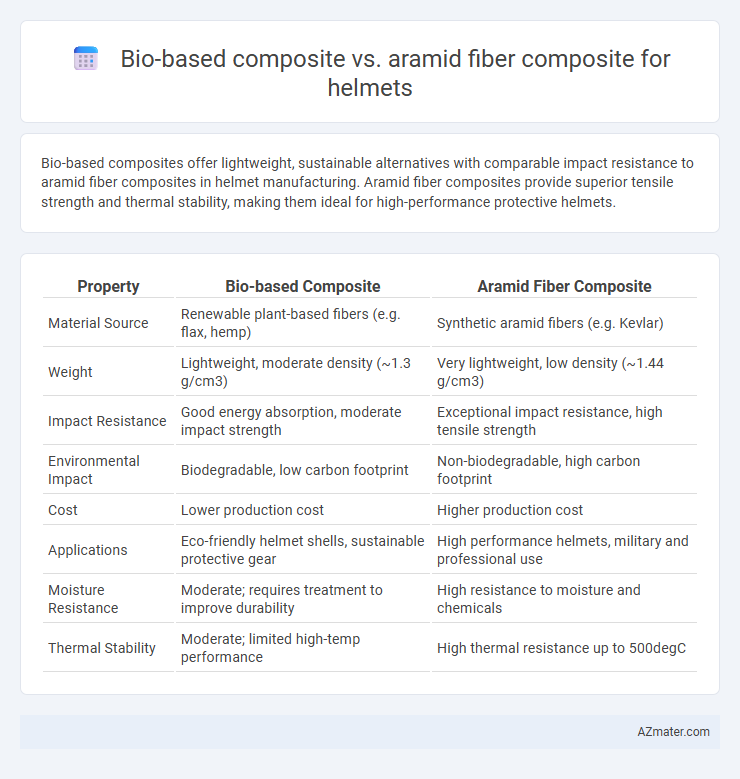Bio-based composites offer lightweight, sustainable alternatives with comparable impact resistance to aramid fiber composites in helmet manufacturing. Aramid fiber composites provide superior tensile strength and thermal stability, making them ideal for high-performance protective helmets.
Table of Comparison
| Property | Bio-based Composite | Aramid Fiber Composite |
|---|---|---|
| Material Source | Renewable plant-based fibers (e.g. flax, hemp) | Synthetic aramid fibers (e.g. Kevlar) |
| Weight | Lightweight, moderate density (~1.3 g/cm3) | Very lightweight, low density (~1.44 g/cm3) |
| Impact Resistance | Good energy absorption, moderate impact strength | Exceptional impact resistance, high tensile strength |
| Environmental Impact | Biodegradable, low carbon footprint | Non-biodegradable, high carbon footprint |
| Cost | Lower production cost | Higher production cost |
| Applications | Eco-friendly helmet shells, sustainable protective gear | High performance helmets, military and professional use |
| Moisture Resistance | Moderate; requires treatment to improve durability | High resistance to moisture and chemicals |
| Thermal Stability | Moderate; limited high-temp performance | High thermal resistance up to 500degC |
Introduction to Helmet Composite Materials
Helmet composite materials play a crucial role in impact resistance and weight reduction for safety gear. Bio-based composites, derived from renewable natural fibers and resins, offer sustainability and biodegradability advantages over conventional materials. Aramid fiber composites, such as Kevlar, provide superior tensile strength, heat resistance, and durability, making them a standard choice for high-performance protective helmets.
Overview of Bio-Based Composite Materials
Bio-based composite materials for helmets primarily consist of natural fibers such as flax, hemp, or kenaf reinforced with biodegradable resins, offering enhanced sustainability and reduced environmental impact compared to synthetic alternatives. These composites provide competitive mechanical properties, including good impact resistance and lightweight characteristics, making them suitable for protective gear applications. Their renewable sourcing and potential for lower carbon footprints present a valuable advancement in eco-friendly helmet manufacturing technologies.
Understanding Aramid Fiber Composites
Aramid fiber composites, widely used in helmet manufacturing, offer exceptional tensile strength and impact resistance due to their molecular structure, which enhances durability and energy absorption. These composites provide superior protection against high-velocity impacts compared to bio-based composites, making them ideal for military and law enforcement helmets. Despite higher environmental benefits of bio-based composites, aramid fiber composites maintain unparalleled performance standards essential for critical safety applications.
Mechanical Properties Comparison
Bio-based composites for helmets offer lightweight and sustainable mechanical properties with tensile strengths typically ranging from 50 to 150 MPa and moderate impact resistance, making them environmentally favorable but less robust than synthetic alternatives. Aramid fiber composites, such as Kevlar, deliver superior mechanical performance with tensile strengths exceeding 3000 MPa, exceptional impact resistance, and high toughness, providing enhanced protection against ballistic and blunt force impacts. The superior stiffness and energy absorption capabilities of aramid fiber composites make them the preferred choice in high-performance helmet applications where maximum safety and durability are critical.
Impact Resistance and Lightweight Advantages
Bio-based composites in helmets offer superior impact resistance due to their energy-absorbing natural fibers like hemp and flax, providing a biodegradable and sustainable alternative. Aramid fiber composites, such as Kevlar, deliver exceptional lightweight strength and high tensile properties, enhancing protection without adding bulk. The combination of bio-based composites' eco-friendliness with aramid fibers' durability presents innovative solutions for lightweight, impact-resistant helmet designs.
Environmental Sustainability and Lifecycle Analysis
Bio-based composites for helmets offer significant environmental benefits through reduced carbon footprints and biodegradability compared to aramid fiber composites, which rely on energy-intensive production processes and non-renewable petroleum-based materials. Lifecycle analysis reveals bio-based composites generate lower greenhouse gas emissions during manufacturing, use, and end-of-life phases, promoting circular economy principles by enabling composting or recycling. Despite slightly lower mechanical performance, bio-based composites demonstrate superior sustainability metrics, making them a preferable choice for eco-conscious helmet design.
Cost Analysis: Bio-Based vs Aramid Fiber Helmets
Bio-based composite helmets generally offer a lower material cost compared to aramid fiber composites, primarily due to the renewable nature and abundant availability of bio-based fibers like flax or hemp. Aramid fiber helmets, such as those using Kevlar, incur higher expenses driven by complex manufacturing processes and the premium price of synthetic fibers. When evaluating total helmet cost, bio-based composites present an attractive option for budget-conscious consumers seeking sustainable alternatives without sacrificing essential protective performance.
Manufacturing Processes and Scalability
Bio-based composite helmets utilize sustainable fibers like flax or hemp combined with bio-resins through processes such as compression molding or resin transfer molding, offering environmental benefits and potential for localized production. Aramid fiber composites, commonly using materials like Kevlar, require more energy-intensive manufacturing methods including filament winding and autoclave curing, which enhance strength and impact resistance but limit rapid scalability. While bio-based composites present a cost-effective and scalable approach for mass manufacturing in eco-conscious markets, aramid composites maintain superior performance in high-stress applications despite higher manufacturing complexity and costs.
Safety Standards and Certification Compliance
Bio-based composites for helmets increasingly meet international safety standards such as EN 1078 and DOT FMVSS 218, showcasing strong impact resistance and energy absorption comparable to traditional Aramid fiber composites. Aramid fiber composites maintain leading compliance with stringent certifications like Snell and ECE 22.05 due to their superior tensile strength and high-performance heat resistance. Both materials undergo rigorous testing protocols, but Aramid composites typically offer higher consistency in certification compliance for professional-grade protective helmets.
Future Trends in Helmet Composite Technology
Future trends in helmet composite technology emphasize sustainable materials like bio-based composites, which offer reduced environmental impact and enhanced biodegradability compared to traditional aramid fiber composites. Innovations in bio-resin matrices combined with natural fibers aim to match or surpass the mechanical strength and impact resistance of aramid fibers, driving advancements in eco-friendly, high-performance helmet designs. Ongoing research focuses on optimizing fiber-matrix adhesion and developing hybrid composites to achieve lightweight, durable helmets with superior energy absorption capabilities.

Infographic: Bio-based composite vs Aramid fiber composite for Helmet
 azmater.com
azmater.com